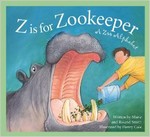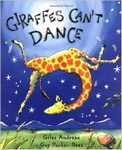Soon after I became a reviewer Sleeping Bear Press began to produce its wonderful alphabet books. What I love about these titles is that they combine poems, artwork, and nonfiction text to give readers a really different reading experience. The books can be enjoyed on many levels by readers of different ages.
Z is for Zookeeper: A Zoo Alphabet
 Marie and Roland Smith
Marie and Roland SmithIllustrated by Henry Cole
Poetry and Nonfiction Picture Book
For ages 6 to 10
Sleeping Bear Press, 2005, 978-1585363292
In the past zoos were places of entertainment for people, who went there to laugh at the monkeys, to shiver when they looked at the snakes, and to gawp at the lions. Often they were not happy places for the animals that lived in them, most of whom had been captured in the wild. These days zoos are very different. They still entertain it is true, but they also educate visitors, and some zoos also serve as a powerful tool in the animal conservation toolbox.
In this wonderful alphabet book each letter of the alphabet focuses on one aspect of zoo life. For each of the twenty-six topics that we encounter on the pages, we are given a short poem to read, a piece of artwork to look at, and a section of text (in a side bar) to read. For the letter A we begin, not surprisingly, with animals and we learn that “Caring for creatures / is what zookeepers do.” The text in the sidebar tells us about how important zoos are in the effort to save certain animal species from extinction.
Zookeepers do all kinds of jobs, but one thing they do a lot is clean. They have to clean the animal’s living spaces every day so that the animals stay healthy and happy. With brooms (on the letter B page) and disinfectant (on the D page) they work hard so that their charges don’t get sick.
On the G page we learn about giraffes, and we also learn that animals are moved from zoo to zoo all the time. When babies are born in a zoo they are often sent, when they are old enough, to another zoo that does not have many or any of that particular species. Transporting a snake or a small monkey is not that hard to do, but transporting a giraffe presents some unique problems, which we can see when we look at the artwork on the page. Giraffes need to travel standing up and an adult can be up to 18 feet tall. How does one get such a tall animal under a low bridge or overpass?
The wonderful thing about the Sleeping Bear Press alphabet books is that they can be enjoyed on many levels. Little children can look at the pictures while the poems are being read to them and then, when they older, they can have the sidebar text read to them, or they can start trying to read these sections themselves.
This is one of the titles in a series of alphabet books that explore the kinds of topics children enjoy learning about. Other books in the series include H is for Horse, T is for Teachers, and G is for Galaxy.








